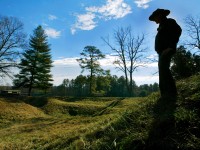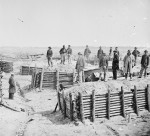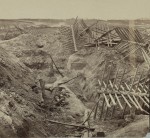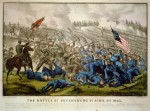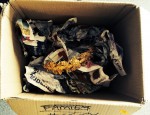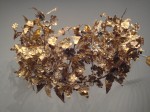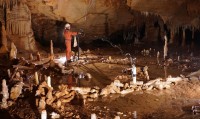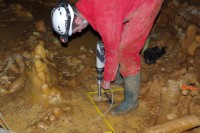 Humans have been brewing beer since at least 6000 B.C. in Mesopotamia — a study was just published a few days ago revealing a 5,000-year-old recipe for beer derived from residue inside pottery found in China’s Shaanxi province — but for thousands of years the chemical processes of fermentation were mysterious. Ingredients varied widely, and even when stripped to the bare bones, as with Bavaria’s 1516 beer purity law, the Reinheitsgebot, which stipulated that beer could only be made from water, hops and malted barley, things could still go horribly wrong. Some barrels from the same brew could go bad. This bad beer or “beer sickness” made the beverage undrinkable, or drinkable only at a great cost in intestinal discomfort.
Humans have been brewing beer since at least 6000 B.C. in Mesopotamia — a study was just published a few days ago revealing a 5,000-year-old recipe for beer derived from residue inside pottery found in China’s Shaanxi province — but for thousands of years the chemical processes of fermentation were mysterious. Ingredients varied widely, and even when stripped to the bare bones, as with Bavaria’s 1516 beer purity law, the Reinheitsgebot, which stipulated that beer could only be made from water, hops and malted barley, things could still go horribly wrong. Some barrels from the same brew could go bad. This bad beer or “beer sickness” made the beverage undrinkable, or drinkable only at a great cost in intestinal discomfort.
 It was only in the late 19th century that a cure was found for beer sickness. Mycologist Dr. Emil Christian Hansen, who in addition to being a veritable paragon of human determination is pretty much directly responsible for every healthy sip of lager you’ve ever had. Hansen was born in Ribe, Denmark, in 1842, the son of a hardworking laundress and an alcoholic Foreign Legion vet who lived on the streets a homeless drifter. To help support the family, from an early age Hansen took on all kinds of jobs, from acting to house painting. When he got a steady job as a tutor, he was finally able to support his formal schooling. He graduated high school at the age of 29 and matriculated at the University of Copenhagen where he studied zoology with a particular interest in fungi.
It was only in the late 19th century that a cure was found for beer sickness. Mycologist Dr. Emil Christian Hansen, who in addition to being a veritable paragon of human determination is pretty much directly responsible for every healthy sip of lager you’ve ever had. Hansen was born in Ribe, Denmark, in 1842, the son of a hardworking laundress and an alcoholic Foreign Legion vet who lived on the streets a homeless drifter. To help support the family, from an early age Hansen took on all kinds of jobs, from acting to house painting. When he got a steady job as a tutor, he was finally able to support his formal schooling. He graduated high school at the age of 29 and matriculated at the University of Copenhagen where he studied zoology with a particular interest in fungi.
(Random historical connection interlude: when he was a student at the University of Copenhagen, Hansen was the assistant of Professor of Zoology Japetus Steenstrup. Steenstrup, also head of the university-affiliated Royal Natural History Museum, in 1850 loaned Charles Darwin some modern and fossil barnacle specimens from his personal collection to aid Darwin in his research for On the Origin of Species. Four years later Darwin expressed his gratitude by gifting Steenstrup with 77 barnacle fossils, 55 of which were discovered in storage and put on display at the Natural History Museum in 2014. In 1876, Hasen would co-author the first Danish language translation of Darwin’s The Voyage of the Beagle.)
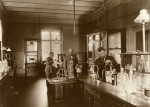 In 1877, Emil Hansen got a job at Copenhagen’s Carlsberg Brewery reserching “organisms in beer.” The Carlsberg Laboratory had opened in 1875, the brainchild of brewery founder Jacob Christian Jacobsen, its mission advancing knowledge of biochemistry and brewery science. Just two years later, Hansen was head of the laboratory. In 1883, he made a momentous breakthrough while studying yeast. He realized bad beer wasn’t caused solely by bacterial contamination, as Louis Pasteur had proposed, but also by contamination from wild yeast strains. He isolated a single cell of favorable yeast and grew it into a pure yeast culture he called “Unterhefe Nr. I” (bottom-fermenting yeast no. 1) which when used as the sole yeast source in the fermentation process ensured that the microorganisms which caused beer sickness would not develop in the lager.
In 1877, Emil Hansen got a job at Copenhagen’s Carlsberg Brewery reserching “organisms in beer.” The Carlsberg Laboratory had opened in 1875, the brainchild of brewery founder Jacob Christian Jacobsen, its mission advancing knowledge of biochemistry and brewery science. Just two years later, Hansen was head of the laboratory. In 1883, he made a momentous breakthrough while studying yeast. He realized bad beer wasn’t caused solely by bacterial contamination, as Louis Pasteur had proposed, but also by contamination from wild yeast strains. He isolated a single cell of favorable yeast and grew it into a pure yeast culture he called “Unterhefe Nr. I” (bottom-fermenting yeast no. 1) which when used as the sole yeast source in the fermentation process ensured that the microorganisms which caused beer sickness would not develop in the lager.
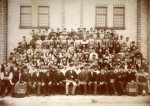 Carlsberg yeast no. 1 went into production in November 1883. Jacobsen was a philanthropic, progressive-minded man who was deeply committed not just to enlisting science to produce excellent beer, but to supporting scientific endeavors for the betterment of mankind in general. Jacobsen could have easily patented the “clean yeast” isolated in his laboratory, but instead he spread the purified yeast culture far and wide, reaching out to competitors and offering them living yeast specimens free of charge. Thus Carlsberg ended lager’s beer sickness problem and lager began its reign as the most popular beer in the world, today comprising 90% of all beer sold. Most of the lager produced today uses the same strain isolated by Hansen and distributed by Jacobsen.
Carlsberg yeast no. 1 went into production in November 1883. Jacobsen was a philanthropic, progressive-minded man who was deeply committed not just to enlisting science to produce excellent beer, but to supporting scientific endeavors for the betterment of mankind in general. Jacobsen could have easily patented the “clean yeast” isolated in his laboratory, but instead he spread the purified yeast culture far and wide, reaching out to competitors and offering them living yeast specimens free of charge. Thus Carlsberg ended lager’s beer sickness problem and lager began its reign as the most popular beer in the world, today comprising 90% of all beer sold. Most of the lager produced today uses the same strain isolated by Hansen and distributed by Jacobsen.
 Three years ago during construction outside the Carlsberg Laboratory in Copenhagen, three bottles of beer, still corked and in remarkably good condition, late 19th century labels and all, were discovered in a forgotten cellar. Researchers at the lab uncorked one and sipped the contents. It was still good, apparently, although it no longer tasted like lager so much as a sherry or port. Carlsberg Laboratory scientists then took samples from the bottle in an attempt to isolate the original live brewing yeast that revolutionized lager production worldwide. Nobody thought they’d be successful, but against all predictions, after a year of research they succeeded, thanks to the thick layer of precipitate at the bottom of the bottle which was characteristic of late 19th century lager.
Three years ago during construction outside the Carlsberg Laboratory in Copenhagen, three bottles of beer, still corked and in remarkably good condition, late 19th century labels and all, were discovered in a forgotten cellar. Researchers at the lab uncorked one and sipped the contents. It was still good, apparently, although it no longer tasted like lager so much as a sherry or port. Carlsberg Laboratory scientists then took samples from the bottle in an attempt to isolate the original live brewing yeast that revolutionized lager production worldwide. Nobody thought they’d be successful, but against all predictions, after a year of research they succeeded, thanks to the thick layer of precipitate at the bottom of the bottle which was characteristic of late 19th century lager.
 With a living culture of the original Unterhefe Nr. I, Carlsberg’s brewers set to the challenging task of recreating the first consistent quality lager. While the brewery has exceptional archives and even a museum, there is no exact recipe for the 1883 lager. All they had to go on in the records was the ratio of water, malt and hops, because the brewers back then didn’t write down the detailed recipe. At the time the brewery really only made one type of beer, and brewers worked on multiple batches a day. They knew the recipe backwards and forwards, so they didn’t bother to document it in writing.
With a living culture of the original Unterhefe Nr. I, Carlsberg’s brewers set to the challenging task of recreating the first consistent quality lager. While the brewery has exceptional archives and even a museum, there is no exact recipe for the 1883 lager. All they had to go on in the records was the ratio of water, malt and hops, because the brewers back then didn’t write down the detailed recipe. At the time the brewery really only made one type of beer, and brewers worked on multiple batches a day. They knew the recipe backwards and forwards, so they didn’t bother to document it in writing.
The ratio was a solid starting point, though, and they did know a great deal about the sources of ingredients and the equipment used. They acquired floor-malted barley malt (floor malting was the system used in 1883). They secured well water drawn through the chalk layer that underlays Copenhagen, just as the water from the 68-foot feep well that supplied the Carlsberg brewery in 1883 was. They used “Gammel Dansk” barley, one of the first domestic barleys J.C. Jacobsen considered of high enough quality to use instead of importing Scottish and British varieties. Like the 1883 brew, the rebrew was not filtered or pasteurized, nor was gelatin added to clear the brew of hazy sediment.
 Because perfectionism is the name of the game, the brewers called in glassblower Peer Nielsen from the Holmegaard glassworks, the oldest in Denmark founded in 1825. Holmegaard has been making Carlsberg bottles since the 1850s. Nielsen consulted with Carlsberg museum staff and glass collectors to determine what kind of bottle would have been used in 1883. He found that machine moulded glass bottles were only produced starting in the 1890s, so he used a wooden mould and to mouth-blow the green glass bottles just as his vocational ancestors had done.
Because perfectionism is the name of the game, the brewers called in glassblower Peer Nielsen from the Holmegaard glassworks, the oldest in Denmark founded in 1825. Holmegaard has been making Carlsberg bottles since the 1850s. Nielsen consulted with Carlsberg museum staff and glass collectors to determine what kind of bottle would have been used in 1883. He found that machine moulded glass bottles were only produced starting in the 1890s, so he used a wooden mould and to mouth-blow the green glass bottles just as his vocational ancestors had done.
On May 18th, the press, craft beer producers, connoisseurs and critics were invited the first tasting of the rebrew, named the Father of Quality Lager.
“I’m relieved,” Bjarke Bundgaard, a beer history expert for Carlsberg, told Live Science after the cask was tapped. “We were very afraid of unwanted microorganisms visiting in the barrel. But basically the beer fulfills what I would expect: rich, malty, higher levels of residual sugars. I think it’s quite authentic, so I’m satisfied.”
 The lager was darker in color, sweeter and less fizzy than the familiar green-bottled Carlsberg pilsner of today, and it had 5.7 percent alcohol content (just short of their goal of 5.8 percent). Bundgaard said the historic lager was not as flavorful as the craft beers of today because “this was an everyday-life beer —it was something that people were drinking for lunch or even for their breakfast.”
The lager was darker in color, sweeter and less fizzy than the familiar green-bottled Carlsberg pilsner of today, and it had 5.7 percent alcohol content (just short of their goal of 5.8 percent). Bundgaard said the historic lager was not as flavorful as the craft beers of today because “this was an everyday-life beer —it was something that people were drinking for lunch or even for their breakfast.”
 Only around 30 bottles of the rebrew were made and there are no plans for retail production, but Carlsberg will be holding beer tasting events around the world. Enter your name and email here to be notified should there be one in your neck of the woods.
Only around 30 bottles of the rebrew were made and there are no plans for retail production, but Carlsberg will be holding beer tasting events around the world. Enter your name and email here to be notified should there be one in your neck of the woods.
 Last week the National Museum of Computing at Bletchley Park discovered the teleprinter of a Lorenz SZ42 cipher machine for sale as a “telegram machine” on eBay. Museum volunteers went to Southend to inspect it in person. They found it in its original case on the floor of a shed, confirmed it was a Lorenz teleprinter and paid the seller the “Buy it now” price of £9.50 ($14). It is going on display with a Lorenz SZ42 code machine loaned by the Norwegian Armed Forces Museum to tell the full story of how the British broke the Lorenz code.
Last week the National Museum of Computing at Bletchley Park discovered the teleprinter of a Lorenz SZ42 cipher machine for sale as a “telegram machine” on eBay. Museum volunteers went to Southend to inspect it in person. They found it in its original case on the floor of a shed, confirmed it was a Lorenz teleprinter and paid the seller the “Buy it now” price of £9.50 ($14). It is going on display with a Lorenz SZ42 code machine loaned by the Norwegian Armed Forces Museum to tell the full story of how the British broke the Lorenz code.  Little did the Nazis know the British deciphered the code six months after the first experimental Lorenz SZ40 started sending data in June of 1941. A remarkable feat of reverse engineering by cryptographer Bill Tutte cracked the code in January 1942. Tutte and his team at Bletchley Park figured out the design and function of the machine without ever having seen one. Operator error in a message transmitted from Athens to Vienna on August 30th, 1941, gave the cryptographers a unique opportunity Bletchley to figure out the plain text and the keystream.
Little did the Nazis know the British deciphered the code six months after the first experimental Lorenz SZ40 started sending data in June of 1941. A remarkable feat of reverse engineering by cryptographer Bill Tutte cracked the code in January 1942. Tutte and his team at Bletchley Park figured out the design and function of the machine without ever having seen one. Operator error in a message transmitted from Athens to Vienna on August 30th, 1941, gave the cryptographers a unique opportunity Bletchley to figure out the plain text and the keystream.  Bletchley analysts saw their first Lorenz cipher machine in 1945. By then they had intercepted and read enormously important tactical messages for four years. That’s how the Allies were able to confirm that the Germans had swallowed their bluff that the D-Day landings were happening at Calais. The breaking of Lorenz also played a major role in the construction of Colossus, the first programmable computer. Post Office engineer Tommy Flowers devised Colossus to calculate the positions of the 12 wheels of the Lorenz code machine in hours rather than weeks.
Bletchley analysts saw their first Lorenz cipher machine in 1945. By then they had intercepted and read enormously important tactical messages for four years. That’s how the Allies were able to confirm that the Germans had swallowed their bluff that the D-Day landings were happening at Calais. The breaking of Lorenz also played a major role in the construction of Colossus, the first programmable computer. Post Office engineer Tommy Flowers devised Colossus to calculate the positions of the 12 wheels of the Lorenz code machine in hours rather than weeks. The code machine is missing its motor. The museum hopes there’s a Lorenz motor out there in someone else’s shed that would allow them to restore the whole apparatus to working order. If you see something in your attic that looks like a motor in smooth black capsule-like casing with shafts on both sides manufactured by the Lorenz Company at Tempelhof in Berlin, please contact the National Museum of Computing.
The code machine is missing its motor. The museum hopes there’s a Lorenz motor out there in someone else’s shed that would allow them to restore the whole apparatus to working order. If you see something in your attic that looks like a motor in smooth black capsule-like casing with shafts on both sides manufactured by the Lorenz Company at Tempelhof in Berlin, please contact the National Museum of Computing.